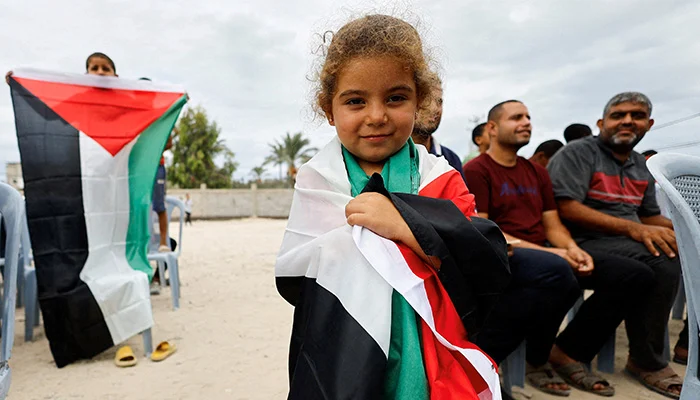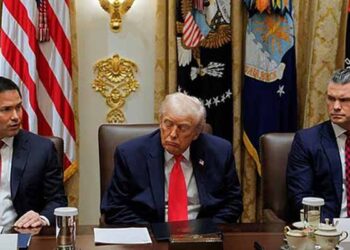Select Language:
A girl waves a Palestinian flag after President Donald Trump announced that Israel and Hamas have agreed on the initial phase of a Gaza ceasefire in central Gaza on October 9, 2025. — Reuters
Israelis and Palestinians celebrated Thursday following the announcement of a ceasefire and hostage agreement, marking the first step in President Trump’s plan to end the conflict in Gaza.
Both sides publicly supported the deal and were expected to sign it around noon in the Egyptian resort town of Sharm el-Sheikh (0900 GMT), although no official confirmation of the signing was immediately available. The Israeli Prime Minister’s office stated that the ceasefire would take effect once approved by the government, which was set to meet after a security cabinet session at 5 pm. Israeli hostage coordinator Gal Hirsch mentioned that negotiations over the list of prisoners to be released were still ongoing.
Residents in Gaza reported a series of airstrikes in Gaza City around the time the deal was supposed to be signed.
Ceasefire, Withdrawal, and Release of Hostages
The agreement entails a halt in fighting, partial Israeli withdrawal from Gaza, and the release of Hamas-held hostages taken during the attack that initiated the war, in exchange for Palestinian prisoners held by Israel. A source familiar with the negotiations indicated that Israeli forces would begin pulling back within 24 hours of the deal’s signing.
The release of all 20 Israeli hostages believed to still be alive in Gaza is anticipated on Sunday or Monday. Meanwhile, 26 others have been declared dead in absentia, and the fate of two remains unknown. Hamas has suggested it might need additional time to recover bodies scattered across Gaza.
Celebrations erupted among Palestinians and the families of Israeli captives after the news of the accord. In Gaza, where over two million residents have been displaced by Israeli airstrikes, young men cheered in the devastated streets despite ongoing strikes.
“All of Gaza is happy,” said Abdul Majeed Abd Rabbo in Khan Younis, southern Gaza. “Thank God for the ceasefire, the end of bloodshed and killing. The entire Gaza Strip, the Arab world, and everyone around the globe are relieved.”
In Tel Aviv’s Hostages Square, Einav Zaugauker, whose son Matan is among the last captives, expressed overwhelming relief. She described her feelings as impossible to breathe or explain, holding a flare in a moment of celebration.
Despite the agreement, Israeli airstrikes continued overnight and into the morning on suburbs of Gaza City. The Gaza health ministry reported at least nine Palestinians killed by Israeli fire in the past 24 hours.
Palestinian children joyfully celebrated at Al-Aqsa Martyrs Hospital in Deir al-Balah, central Gaza, following the announcement of the ceasefire and initial talks in Egypt. This breakthrough came just a day after the second anniversary of Hamas’s cross-border attack that sparked Israel’s devastating assault on Gaza, which resulted in over 67,000 Palestinian deaths, the killing of 1,200 Israelis, and the capture of 251 hostages.
The agreement was seen as a major diplomatic victory for President Trump, who had campaigned on promises to end the fighting in Gaza. He called it a “great day” for the Arab and Muslim world, Israel, surrounding countries, and the U.S., thanking mediators from Qatar, Egypt, and Turkey for their roles.
However, many questions remain unanswered, including plans for Gaza’s post-war governance and the fate of Hamas, which refuses to disarm and accept Israel’s terms. Israeli Prime Minister Netanyahu described the deal as “a diplomatic success and a moral victory,” though hardline coalition members oppose any deal with Hamas. Some, like Finance Minister Bezalel Smotrich, insisted Hamas must be destroyed once the hostages are released, though he stopped short of challenging Netanyahu’s government.
Support for the agreement came from many Arab and Western nations tired of repeated ceasefire failures. The next phase of Trump’s plan envisions an international body led by the president, possibly including former British Prime Minister Tony Blair, to oversee Gaza’s reconstruction and governance.
Opposition by Hamas and Israel’s ideological critics continues, with stakeholders divided on Gaza’s future, especially concerning international control and Palestinian statehood aspirations. The conflict has claimed over 67,000 Palestinian lives, sparked by Hamas’s attack on Israeli towns, which also led Israel to conduct extensive military campaigns across Lebanon, Iran, and the broader Middle East, shifting regional power dynamics. Yet, international outrage against Israel’s recent actions has led to a growing sense of isolation for the country.







